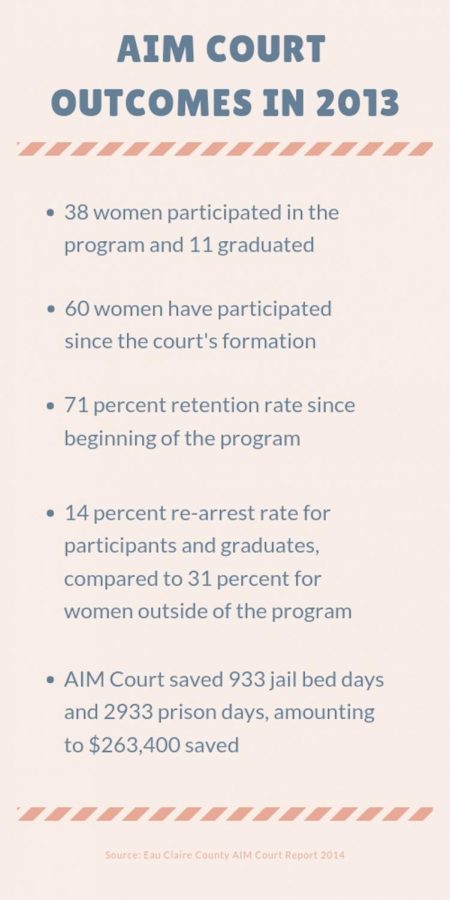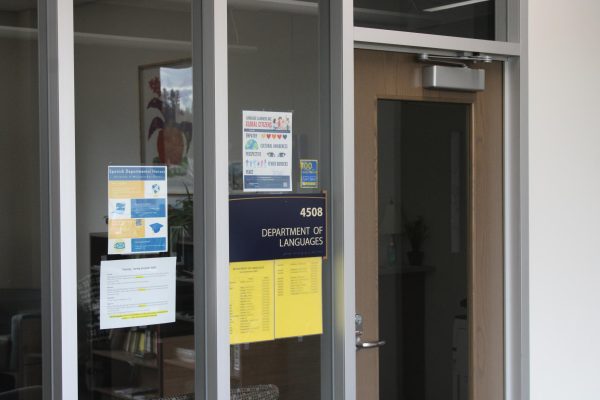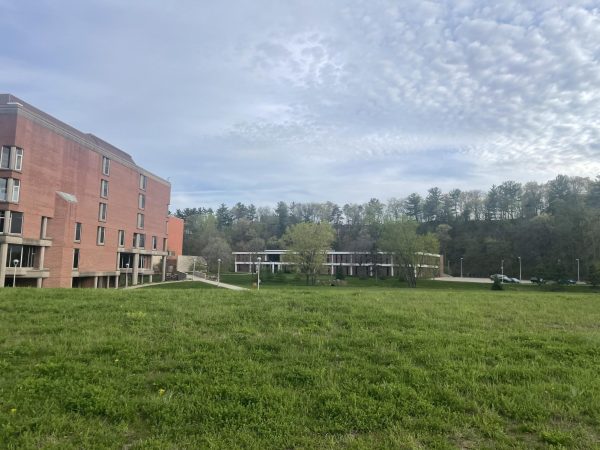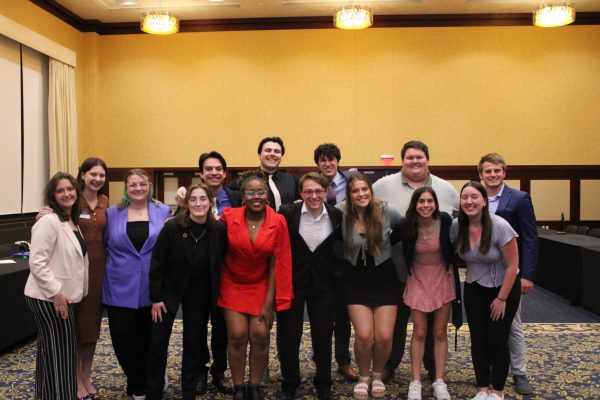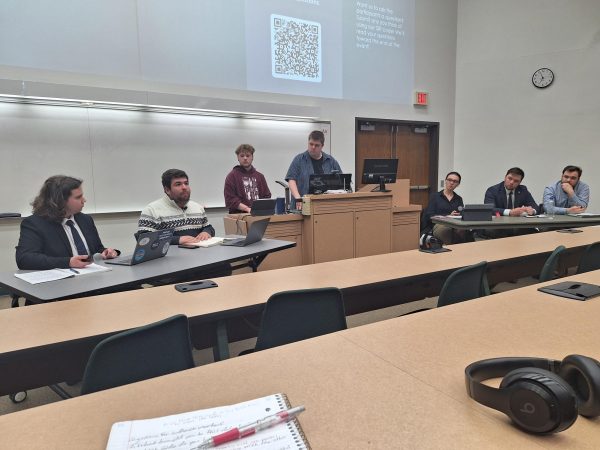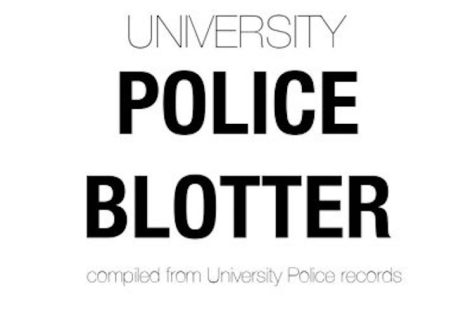AIM Court supports Eau Claire county women recovering from drug addiction
Court officials: Treatment beats incarceration
Photo by SUBMITTED
Alternatives to Incarcerating Mothers Court (AIM Court) is a branch of the treatment court system under Eau Claire County jurisdiction. Its goals are to help women who struggle with addiction.
Jessica Barker was addicted to alcohol. She spent her nights bouncing between friends’ sofas and the Bolton Refuge House in downtown Eau Claire. Barker’s sons, Oakland and Noah, were in foster care, and for this she carried a tremendous amount of guilt and shame.
If it wasn’t for AIM Court, at the very least, Barker said, she would not be sober. At the very worst, she’d be dead.
“I had to put myself first,” Barker said. “I had to get healthy, not only for (my children), but for myself.”
Alternatives to Incarcerating Mothers Court (AIM Court) is a branch of the treatment court system under Eau Claire County jurisdiction. Its goals are to help women who struggle with addiction. Court officials agree the program is a successful approach to tackling drug and substance addiction in western Wisconsin but say the problem will continue to persist if the community doesn’t work to support people healing from addiction.
Launched in 2007, AIM Court was a response to the growing number of women who were homeless, in need of child welfare services or interventions and struggling with substance addiction, according to the court’s website.
A gendered approach to treatment is more effective than a mixed-gender court, said the court’s coordinator Marsha Schiszik and Judge John Manydeeds. Both said they’ve seen studies proving treatment tailored to women’s needs is more effective.
Women risk encountering men who’ve abused them while in a mixed-gender treatment court, Manydeeds said. This can destroy the program’s safe atmosphere, disrupt the woman’s treatment and cause a woman further trauma.
Barker said her progress in AIM Court would have been hindered if men had been included.
“An all-women’s treatment court is more intimate compared with other drug courts,” Barker said.
The court used to deal with low-risk, low-need women with minimal involvement in the criminal justice. Today, AIM Court serves women who are on probation with higher risks and needs. Some women have longer criminal histories of nonviolent crimes or misdemeanors. Some are parents, as the name indicates, but having a child is not a requirement for court entry.
Participants are referred to AIM Court by a judge, public defender, private attorney, district attorney, community corrections or a jail or human services staff member. A participant is evaluated via an interview and assessment.
If she is willing and demonstrates eligibility, the participant is admitted to AIM Court where she will move through four phases of treatment.
Court sessions are held at 8:30 a.m. every Tuesday in the County Courthouse Branch One courtroom with Manydeeds, who moved into the position in 2016 after more than 10 years of experience in other treatment courts.
Tuesday mornings take on an informal tone for a courtroom — participants often come dressed in jeans, hoodies and sweatpants. The only traditional courtroom detail present during AIM Court sessions is Manydeeds’ perch atop the judge’s bench.
Manydeeds calls each participant up to a seat at the front of the room and announces her sober date. Applause follows. Then, the judge begins a dialogue.
He asks each woman specific questions about her treatment, her life and her children. If he sees fit, Manydeeds also assigns reading and writing assignments. He is quick to offer encouragement.
“You are much more optimistic, driven (and) you have goals and aspirations,” Manydeeds told one woman who’d overcome barriers in her treatment. “It’s all about your wants and needs. If you want it, you can do it.”
Still, the courtroom sessions are only one dimension of treatment. Certain needs have to be met for a person struggling with addiction to begin to work toward remission. Schiszik calls these needs “responsivity.” Safe housing, mental and physical health, childcare and food security are all key ingredients on the path to recovery.
Behind the scenes, each woman has a “treatment team” whose members work with her for the duration of her time in AIM Court, an average of 15 months. The team meets weekly with the participants to address their treatment plans and responsivity needs.
A treatment team can include Manydeeds, the district attorney or an assistant district attorney, Court Coordinator Schiszik, a jail/work release captain, a representative from the treatment provider and a family service worker.
Schiszik oversees the treatment team, regularly meets with participants and plans community-building events. She works with community substance treatment providers, landlords and employers.
It can be a battle for a person recovering from substance abuse to obtain safe, affordable housing. Those with criminal records aren’t protected by the Fair Housing Act; landlords and home-sellers can deny an applicant with a criminal record.
The problem arises when landlords and home-sellers refuse to rent or sell to anyone with a criminal record without looking at individual cases. The Department of Housing and Urban Development (HUD) released a guiding statement in 2016 telling landlords and home-sellers that a blanket rejection based on criminal records may violate the Fair Housing Act.
AIM Court participants find the same barriers when searching for employment. If a person has a history of theft, for example, employers hesitate to hire them.
Schiszik said she understands the concerns of landlords and employers. She encourages participants to be upfront with their criminal records. Schiszik said the team often succeeds in finding a participant housing or a job because of their honest tactics.
It’s been nearly eight years since Schiszik took on coordinating AIM Court. Schiszik’s office is a small, humble square on the second floor of the Human Services building. In the corner, a pile of knotted blankets leans against a file cabinet. Two iPhones, one for participant contact and one for personal use, recline on her keyboard.
Prior to coming to AIM Court, Schiszik worked with patients and their families at an in-patient treatment facility. When she gave birth to twins of her own, she became even more connected to helping families stay together.
Today, Schiszik said her work in AIM Court teaches her about the resiliency and bravery of the women she encounters in the system.
“You’ve got to swallow a lot of pride to constantly be asking for help,” Schiszik said. “We’re talking about things that people don’t want to talk about.”
Schiszik said the stories participants tell her, some of which are hard not to bring home with her, affect her deeply. It’s easy to doubt the justice system when it’s failed the people she interacts with every day, Schiszik said.
When she starts to feel burnt out, Schiszik says she takes time for herself. The desk drawer next to her chair holds letters from previous AIM Court alumni. She reads those letters when she has a hard day.
“It’s empowering to work with women,” Schiszik said. “We are so strong. Watching them find their strength is amazing.”
Addiction: a disease
The National Institute on Drug Abuse’s website defines drug addiction as a “chronic, relapsing disorder characterized by compulsive drug seeking and use despite adverse consequences.”
Most drugs rewire the brain’s “reward circuit,” the website says. A user experiences euphoria as the brain’s dopamine receptors are activated. Dopamine is the same chemical released when eating or spending time with loved ones.
When Barker was admitted into AIM Court, she said her mother asked her, “Why can’t you just grow up?”
But quitting isn’t as simple as it may seem. As the brain adapts to the high received from using, a person can become less interested in activities they once enjoyed that would have released dopamine naturally. Learning, judgement and decision-making are all gripped by drugs.
Doug Matthews is a psychology professor at UW-Eau Claire. Matthews studies the biochemical and behavioral consequences of alcohol use and abuse.
“Addiction profoundly changes the brain,” Matthews said. “Some of those changes reverse and some of those changes to do not. So, you’re living the rest of your life with a compromised brain — and a compromised brain often makes compromised choices.”
A person’s age, gender, environment and childhood are all factors that play into their risk of getting addicted, Matthews said.
“In no way do I ever want to remove responsibility of addiction from the addict, but it’s important to recognize that drug use is a coping mechanism in a lot of ways,” he said, “and it is a coping mechanism that gets out of control.”
Addiction in the Chippewa Valley
Cases of drug and alcohol abuse are no stranger to the Eau Claire area, studies say.
“People think that they are not affected by (addiction),” Barker said, “but they are. It’s all around them.”
In 2016, the Wisconsin Epidemiological Profile on Alcohol and Other Drugs compiled data from various sources to unearth trends of substance use and the resulting consequences.
The study found Wisconsinites’ alcohol consumption rate is 1.3 times higher than the national rate. The state’s rates of alcohol abuse and dependence have been higher than the nation as a whole since 2008.
“Alcohol is the most frequently consumed substance of use and misuse in Wisconsin,” the study reads, “contributing to consequences that affect all state residents.”
Indeed, alcohol was a factor in at least 2,008 deaths and 2,907 motor vehicle crash injuries in Wisconsin in 2015.
What is known about drug-of-choice trends appear to be reflected in death reports, too. Annual numbers of drug-related deaths involving opioids, cocaine and/or benzodiazepines in Wisconsin increased from 60 percent in 2006 to 74 percent in 2015.
Methamphetamine popularity has quietly surged alongside heroin. The 2016 Wisconsin Methamphetamine Study conducted analysis based on meth-related arrests, cases, charges and seizure statistics.
Western Wisconsin is an area especially at risk for an increase in meth use, according to the Meth Study. The Chippewa Valley is connected to the drug traffic web because of its proximity to the Twin Cities.
The dangerous implications of drug use are further documented in data collected from criminal records. People who abuse drugs are more likely to commit property crimes in an effort to obtain money to purchase drugs.
Crimes more violent in nature like domestic disturbance, armed robbery and sexual assault are linked to meth use.
In Eau Claire County, concerns about meth abuse surpass that of alcohol abuse. In 2016, the county’s mid-year jail population was 52,314. Of those incarcerated, 21.1 percent faced meth charges while 14.3 percent faced OWI charges.
Drug treatment courts like AIM Court are the final step before sentencing a substance user to time in prison. Putting a person through treatment court is cheaper for taxpayers than incarceration. In 2013, AIM Court saved taxpayers $263,400.
Manydeeds looks beyond the cost-saving value of the court to community impact. He focuses specifically on how families are impacted when a member is sentenced to time in prison.
“There is a dollar figure you can come up with, as far as number of days in jail you can save,” Manydeeds said, “but there’s this other figure that there’s no way you can put a dollar figure on. It’s not possible, because how do you put a value on a person staying in their house to raise their child?”
Manydeeds said children who “age out” of foster care end up homeless. During this time, they may begin to use drugs as a coping mechanism. Keeping children in a household with permanent guardians can break the cycle of addiction because it provides a stable environment. AIM Court’s treatment team works with mothers to help them continue successfully parenting their children.
“If we can take one person and help them to stay off drugs,” Manydeeds said, “the world is a better place. It’s called a ripple effect.”
Barker said she advocates to create more treatment courts, which she believes has a higher success rate for a person fighting addiction and society at large.
“It betters the community,” Barker said. “I’m a healthy, productive member of society, and before I wasn’t.”
Manydeeds, Matthews and Schiszik highlighted the importance of community and support systems during a person’s path to remission.
Support, Matthews said, is particularly important because of the lingering stigma and consequent shame attached to substance addiction. These misconceptions, he added, don’t help people who are addicted begin to heal. Rather, it isolates them during a time when their need for community is critical.
“I think that some of what we can do to ease the stigma is (to) stop judging people and to start knowing people,” Matthews said. “Usually when we know people, we can kind of understand what happened.”
One mid-October Tuesday the Branch One courtroom looked different than normal. A metallic, multi-colored banner hung on the judge’s stand declaring, “Congratulations.” A boxed cake beckoned at the front of the room. Folded quilts adorned with turtles waited to be noticed on another table across the aisle.
“Cassie, sober date Oct. 20, 2017,” Manydeeds said with a grin breaking on his face.
On cue, Cassie took her post in the big gray chair at the front of the room. In the benches behind her sat her mother, twin sisters, boyfriend and son. The toddler squirmed, reined in from restlessly running between benches.
“I think, since I’ve started, I’ve come a long way,” Cassie said. “I think I’m a different person.”
Manydeeds brought up a song Cassie picked out in the middle of her treatment called “If You Want Love” by the artist NF. The judge pressed play and a gentle guitar melody drifted into the air.
“If you want love, you gon’ have to go through the pain
If you want love, you gon’ have to learn how to change
If you want trust, you gon’ have to give some away.”
One AIM Court participant sitting behind Cassie wiped tears from her eyes. She leaned over to the woman next to her, who put her arm around her and rubbed her shoulder.
When the music ended, Cassie explained she’d chosen the song because she could relate closely to the lyrics. Manydeeds agreed: the song was a perfect choice for Cassie and the journey she’d gone through during treatment.
Schiszik walked over to the quilts resting at a table. Giving quilts as a graduation gift is a metaphor, Schiszik said. If a person is struggling, they should wrap the quilt around them and remember the love and support in their life.
Cassie’s son ran to the front of the room to sit in his mother’s lap. Schiszik smiled and handed him a smaller knotted blanket of green and black and covered with turtles. Cassie’s quilt was larger and featured pale pink flowers. Schiszik told Cassie she blossomed during her treatment.
“Addiction is a very isolating disease,” Schiszik said. “I think that maybe AIM Court may be that beacon of hope. You are definitely going places.”
After two and a half years in AIM Court, Barker went places.
Persistent work with temp services earned her a job, and honesty about her record gave Barker a safe home. She is back with her children and pushes herself to be a positive role model for them.
In December Barker will graduate from Chippewa Valley Technical College with an associate degree in alcohol and other drug abuse. She said she plans to become a counselor for people with substance addiction, a decision she said is influenced by her time in AIM Court and the battles she’s won in maintaining her remission.
“I don’t have a choice,” Barker said. “This is my place on this Earth: to be a counselor.”
Barker can still remember her AIM Court graduation. Her boys and their foster mom were there, supporting her. Barker shed a few tears — a “good cry” — because she finally knew how to live without depending on substances.
“It felt like the best accomplishment in my life,” Barker said.
Neupert can be reached at [email protected].
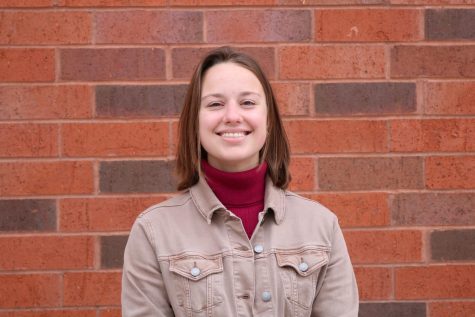
Neupert is a fourth-year journalism student at UW-Eau Claire. She is the executive producer of Engage Eau Claire on Blugold Radio Sunday. In her spare time, Neupert's working on becoming a crossword puzzle expert.

